函数的定义和参数

https://docs.python.org/3.7/tutorial/controlflow.html#defining-functions
https://docs.python.org/3.7/tutorial/controlflow.html#more-on-defining-functions
不定数参数
# -*- coding: utf-8 -*-
def showme(name, *info):
print(name)
for a in info:
print(a)
showme("Lee", 1,2,3,4)

关键字参数
# -*- coding: utf-8 -*-
def showme(name, *info, **info2):
print(name, info)
for b in info2:
print(b, info2[b])
showme("Lee", 1,2,3,4,age=12,sex='女')

获取参数类型
# -*- coding: utf-8 -*-
def showme(name, *info, **info2):
print(type(name))
print(type(info))
print(type(info2))
showme("Lee", 1, 2, 3, 4, age=12, sex='女')

强大到令人发指的Data Structures
https://docs.python.org/3/tutorial/datastructures.html

range函数的使用
items=[]
for x in range(0, 10):
items.append(x)
print(items) # [0, 1, 2, 3, 4, 5, 6, 7, 8, 9]
###################################################
items=[]
for x in range(10, 0, -1):
items.append(x)
print(items) # [10, 9, 8, 7, 6, 5, 4, 3, 2, 1]
#####################################################
print(list(range(0, 10))) # [0, 1, 2, 3, 4, 5, 6, 7, 8, 9]
#####################################################
item=[a**2 for a in range(0, 10, 2)]
print(item) # [0, 4, 16, 36, 64]
#####################################################
# center right left
item=[a**2 for a in range(0, 10, 2) if a>4]
print(item) # [36, 64]
#####################################################
def do(n):
return n + 2
print(list(map(do, [x for x in range(0,10) if x > 5]))) # [8, 9, 10, 11]
Class的初步定义和使用
class Me:
def __init__(self, name):
self.name = name
def show(self):
print(self.name)
@staticmethod
def version():
print('1.0')
me = Me('Lee')
me.show() # Lee
Me.version() # 1.0